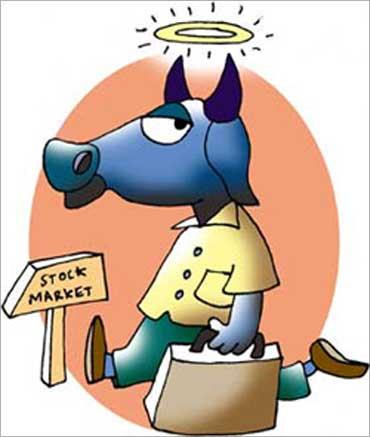Photographs: Rediff Archives Morningstar.in
Also, relying disproportionately on your risk tolerance to shape your asset-allocation strategy carries its own big risk.
Assessing an individual's own assessment of his or her ability to withstand investment losses is standard practice in the financial-planning world.
The Web is full of tools to help investors gauge how they would respond if the market dropped 10 per cent, 20 per cent, or even 50 per cent, and we often hear from investors who say their risk tolerance is 'high' or 'low'. The basic premise behind getting investors to identify their pain thresholds makes sense.
After all, reams of data show that investors often buy high and sell low. By identifying their ability to handle losses and avoiding those investments that will cause them to sell at the wrong time, investors should be able to improve their overall return records.
Yet relying disproportionately on your risk tolerance to shape your investments carries its own big risk: namely, that you'll end up with a portfolio that doesn't help you reach your goals because you've been too aggressive or too timid.
Instead, risk tolerance should take a back seat to the really important considerations, such as the size of your current nest egg, your savings rate, the years you have until retirement, and the number of years you expect to be retired.
Only after you've developed a portfolio plan based on those factors should you consider making adjustments around the margins to suit your risk tolerance.
How to assess your investment risk profile
Photographs: Rediff Archives
The risk of being too aggressive
Generally speaking, we're happy to hear from investors who rate their risk tolerance as 'high.' These people's long-term mindsets allow them to tune out the market's inevitable day-to-day gyrations and weather big losses from time to time -- characteristics that usually go hand in hand with profitable investing.
Yet being too aggressive isn't always a good thing. For one thing, it's possible that you're misreading your own risk tolerance and won't behave as you think you will if and when your investments lose money.
Studies from the field of behavioural finance indicate that investors' confidence level -- and in turn their perceived ability to handle risk -- ebbs and flows with the market's direction.
Thus, an investor might rate highly herhis own ability to handle risk at the very worst time -- when the market is skyrocketing and stock valuations are high -- only to exhibit much less confidence in the event of a market drop (Not surprisingly, buoyant markets are also when most financial services firms hawk the riskiest products).
Moreover, being loss-averse has a foundation in simple mathematics. After all, the stock that drops from 20 to 15 has lost 25 per cent of its value, but it will have to gain 33 per cent to get back to 20.
The same cruel math holds for the whole of your portfolio, so it's no wonder that investors are inclined to rate themselves as risk-averse; losses are tough to recover from.
Big losses can be particularly painful for those who are getting close to retirement, because their portfolios have less time to recover from the hit. If you're 30 and your retirement-plan balance goes down by, say, 35 per cent it's a painful but not a cataclysmic blow.
After all, you might have 30 years or more to recoup those losses, and depressed stock valuations give you the opportunity to buy stocks on the cheap.
By contrast, if you're in your mid-60s and saw your retirement-plan balance shrink by the same percentage term over the past year, you don't have as many options. You could continue working to amass more savings or dramatically scale back your planned standard of living in retirement, neither of which is particularly appealing.
The bottom line is that there are real reasons to grow more protective of your nest egg as you grow closer to needing your money, and there are real risks to letting your own assessment of your risk tolerance guide your asset-allocation decisions.
How to assess your investment risk profile
Photographs: Rediff Archives
...Or too conservative
With extreme volatility seen in the market in the past few years, we'd wager that being too conservative is a bigger risk for many investors right now than is maintaining a portfolio that's too aggressive. Just as investor confidence improves as stocks march upward, so does pessimism take over when stocks are in the dumps.
Yet anyone tempted to make her/his portfolio more conservative should ponder a real risk of that tactic. By avoiding stocks and sticking exclusively with 'safe,' fixed-rate securities such as short-term bonds, you also put a cap on your portfolio's upside potential, which in turn heightens the risk of a shortfall come retirement.
True, stocks have greater loss potential than do short-term fixed-income investments, but they also have the potential for greater gains.
Also, inflation has the potential to gobble up most, if not all, of the return you earn from any fixed-rate investment.
The upshot? For retirees, pre-retirees, and 20-somethings alike, hunkering down in safe, fixed-rate investments is a luxury you probably can't afford, even if it helps you sleep at night.
To help offset the effects of inflation, you need to have at least part of your portfolio in stocks, whose returns have the potential to outstrip inflation over time.
How to assess your investment risk profile
Photographs: Rediff Archives
Just right
So if it's a bad idea to let your gut guide your stock/bond mix, what should you do? Your key mission is to let hard numbers -- rather than your own comfort level -- be the chief determinant of your asset-allocation plan.
Try to optimise your asset allocation based on your goals, your savings rate, and the number of years you have until retirement. Alternatively, you could hire financial advisor for more customised help.
Once you've put your basic asset-allocation framework in place, it's fine to make some adjustments around the margins based on your own comfort level.
For example, if you determine that you should have the majority of assets in equities, you could focus on under-priced large-cap stocks or invest with a stock-fund manager who places a premium on limiting losses.
On the bond side, you could limit your portfolio's risk level by going light on more volatile asset classes like high-yield bonds and sticking with high-quality short- and intermediate-term bonds.
Beyond these small adjustments, it's a big mistake to let your emotions -- and that's essentially what irrational risk aversion is -- drive your portfolio planning.
If the market's ups and downs leave you with excess nervous energy to burn, focus on factors you can actually influence, such as improving your security selection and lowering your overall investment-related and tax costs.






Comment
article